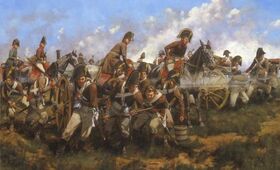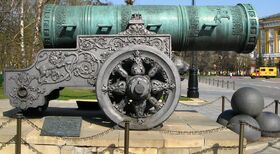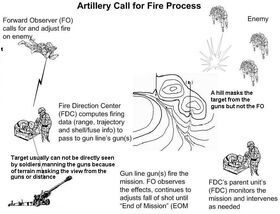
Austrian Field Guns, an example of the Field Artillery
Field Artillery is a term that refers to a group of Cannon/Artillery pieces designed to support infantry. These pieces are renowned for their manouevrability and ability to give a tactical advantage to the deployer. Field Artillery was particularly popular in the 19th century (where it was known as Foot Artillery as the crew would walk alongside the towed carriage) but declined during the late 20th and early 21st centuries. Nonetheless the Field Artillery has survived (albeit now towed by engine power rather than horse) and remains useful in its role as infantry support.
Units[]
The Field Artillery is divided into a range of various units. Each unit is defined by the type of gun it used, with various guns used for specific purposes.
Field Gun[]
The Field Gun was, perhaps the most widely used piece of the Field Artillery. It was designed around the idea of being towed around the battlefield (usually by horses), before being unlimbered and firing a volley of shots at the target. The Field Gun would then be limbered and moved around to a new point in the field. These guns were capable of long range firing, directly supporting infantry.
Howitzer[]

The Tsar Gun, often considered the largest Howitzer in the World
The Howitzer was capable of firing in relatively the same circumstances as the Field Gun. However the Howitzer was limited to firing at higher angles of trajectory (as opposed to the shallow trajectory of the Field Gun) which meant it was more suited to firing at a longer range, as well as being a more indirect support for infantry.
Gun Howitzer[]
The Gun Howitzer, or Field Howitzer, effectively combined the Field Gun and the Howitzer into a gun capable of firing at any angle, achieving long or short ranges and characterised by the long barrel.
Infantry Support Gun[]
The Infantry Support Gun has been largely superceeded by other types of weapon, despite having been the first example of the Field Artillery. These cannon would be used to directly support the infantry, and in some cases would be deployed by the infantry themselves. The Infantry Support Gun was replaced, in part, by the Field Gun but more recently replaced by equipment such as grenade launchers, anti-tank weapons and aircraft.
Mortar[]
The Mortar is defined by its low weight, high angle of trajectory designed to indirectly fire against enemy troops, dropping the projectile above the enemy from a relatively far range. The Mortar is capable of firing at any angle greater than 45 degrees and is deployable by infantry, making its placement easier and quicker than conventional Field Artillery pieces.
Mountain Gun[]
The Mountain Gun is very similar to the Infantry Support Gun, being deployed by infantry in terrain where conventional Field Artillery would be difficult to deploy. These guns can be taken down to ease their transport.
Multiple Rocket Launcher[]
The Multiple Rocket Launcher is a relatively modern development of the Field Artillery, effectively combining the Rocket Launcher to a mobile platform. Despite being more powerful than the conventional Field Artillery pieces, the Multiple Rocket Laucher is usually less accurate with a lower rate of fire.
Team[]

The modern day procedure for firing a Field Artillery piece
The Field Artillery team is made up of several people, each with a specific role in the firing process. This team has developed over the time that the Field Artillery has been used, with the number required to fire the gun dropped but the wider team increased.
Forward Observer (FO)[]
The Forward Observer is tasked with observing where the target is, calling the FDC (Fire Direction Centre) with the grid coordinates, size of the target (recommending the type of ammunition to use) and any other special information that the firing team needs. Once the shot is fired the FO is then instructed to observe where the shell lands, suggesting slight changes in set up before the next shot is fired, stating "Target on, fire for effect" (or words to that effect) when the rest of the team can let loose the Field Artillery.
Prior to the turn of the 20th century this position was virtually non-existent as (all types of) Artillery did not achieve the range that is capable of in the modern day.
Fire Direction Centre (FDC)[]
The Fire Direction Centre is the central (and in many ways most crucial) part of the Field Artillery team. The FDC calculates, from the information sent by the FO, the firing data for the gun. Although this calculation could be done manually (using a system of slides and rules) the system is (now) mostly computerized, improving the speed and in many cases accuracy of the Field Artillery. A single FDC controls information (usually) for up to 6 guns at a time, while also recording both friend and foe positions on the field.
Command Post (CP)[]
The Command Post is located within visible distance of the guns, albeit camouflaged, to allow for quick communication between the FDC and the Guns themselves. The CP is usually in control of the guns, determining when to fire and processing the information/data received from the FDC.
Guns[]
The last in the firing chain, the Gunners receive the information from the FDC (via the CP) before setting up the gun to the FDC's calculations. This setup is done in millimeters, allowing for greater precision and is either done using a system of cranks or hydralics. The Gun then fires on the CP's order.
History[]
The Field Artillery has been a crucial part of any armed forces since the 14th century, being first recorded in its familiar form during the Ming Dynasty. However it was not until the Napoleonic Wars that the Field Artillery became a major factor in infantry to infantry fighting (previously cannon had been used to pound the enemy fort, rather than infantry) with the famed tactics of Napoleon Bonaparte being crucial to the French Republic's successes in the conflict.
Yet the 20th Century lead Field Artillery into a different path, being developed to fire indirectly at enemy positions from a greater distance. This evolution has simultaneously improved the Field Artillery but also replaced it, with the manouevrability of the Field Artillery being replaced by the self-propelled gun (as well as tanks) despite the vast improvement in range and ability. The age of the computer has also revolutionised the Field Artillery as the firing can be placed to a infinintely greater degree of accuracy.
Resources[]
- http://en.wikipedia.org/wiki/Field_artillery
- http://www.iwm.org.uk/ - Imperial War Museum
- Ian V. Hogg - Illustrated Encyclopedia of Firearms